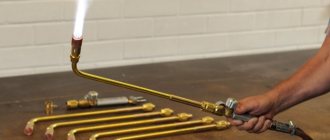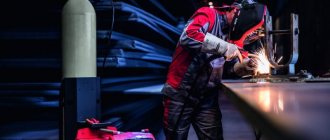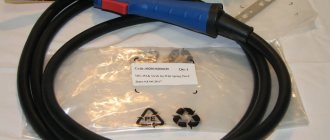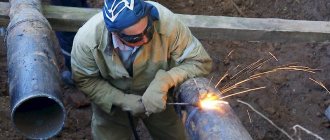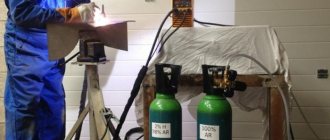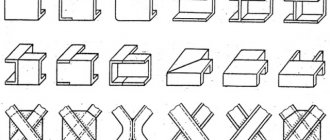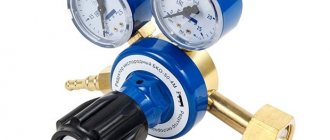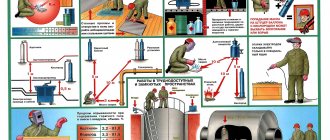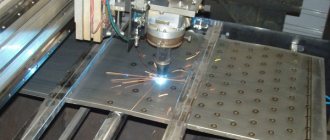Gas hose classes
Depending on the purpose and area of application, oxygen hoses according to GOST 9356-75 are divided into the following classes:
- I – oxygen hoses designed for supplying acetylene, city gas, propane and butane under pressure. The working pressure for which the first class oxygen hose is designed is 6.3 kgf/cm2 (0.63 MPa).
- II – oxygen hoses used for supplying liquid fuel: A-72 gasoline, white spirit, kerosene or mixtures of these liquids at an operating pressure of 6.3 kgf/cm2 (0.63 MPa).
- III – oxygen hoses, operated to supply oxygen at a pressure of 20 kgf/cm2 (2.0 MPa) and 40 kgf/cm2 (4.0 MPa).
Oxygen hose, hoses for gas welding GOST 9356-75
Rubber pressure hoses designed for gas cutting and gas welding are often called oxygen hoses.
The main purpose of welding hoses is to supply working gases under pressure: acetylene, natural gas, butane, propane, oxygen, as well as liquid fuel to equipment used for gas cutting and welding. Gas or oxygen hoses and hoses are widely used for industrial and domestic purposes - at gas stations, manufacturing, for supplying natural gas to residential buildings, in medical institutions, and so on. The regulatory standard establishing the basic technological parameters for a rubber hose for welding and cutting (oxygen and propane hoses) is GOST 9356-75. The operating ambient temperature of such hoses is allowed within the range from -50°C to +65°C.
Oxygen hoses are produced for use in areas with cold, temperate and tropical climates.
The operating temperature range of rubber goods depends on their climatic design and is:
- from -55 to +70°C – frost-resistant hoses with special HL markings, which are intended for areas with cold climates;
- from -35 to +70°C – for temperate and tropical.
Depending on the purpose for which the oxygen hose is intended, products are divided into three classes:
- Class I: for gases (propane, butane, natural gas, acetylene) under pressure P 6.3 kgf/cm2 (0.63 MPa); The hose is red.
- Class II: for supplying flammable liquids (gasoline, kerosene, white spirit or mixtures thereof) under pressure P 6.3 kgf/cm2 (0.63 MPa). The hose is yellow.
- Class III: for oxygen under pressure, two modifications: P 20 kgf/cm2 (2 MPa) and (4 MPa). The hose is blue.
Symbols on gas hoses
The symbol for an oxygen hose according to GOST 9356-75 contains:
- product name,
- class indication,
- internal diameter value in millimeters,
- value of the design pressure in MPa,
- if necessary, climatic version,
- as well as instructions from GOST 356-75.
An example of a symbol for a class I oxygen hose with an internal diameter of 16 mm, designed for a working pressure of 0.63 MPa, operable in areas with a tropical climate: Hose I-16-0.63-T GOST 9356-75.
Oxygen hoses intended for use in areas with cold climates have the symbol “HL” in their designation . The design of oxygen hoses for temperate climates, according to GOST 9356-75, does not require an additional marking symbol.
Symbol and marking of oxygen hose
Each oxygen hose GOST 9356-75 is marked with indelible paint or in relief. The method of marking must ensure its safety and readability throughout the entire service life of the rubber product. For gas welding hoses with a diameter of 6.3 mm. It is allowed to apply markings to the tag and not to the hose itself.
Marking of oxygen hoses GOST 9356-75 contains:
- product designation;
- trademark or name of the manufacturer;
- batch number and release date;
- Quality Control Department stamp indicating product compliance with the requirements of the State Standard.
Colored oxygen hoses are marked with white paint. For black sleeves, the color of the marking depends on the class of the sleeve.
Welding sleeve with longitudinal markings (Fig.)
The marking is applied in the form of a longitudinal line along the entire length of the oxygen hose (intervals are allowed).
The main technical and operational characteristics of oxygen hoses are encrypted in a symbol that contains the following information:
- product name;
- belonging to a class;
- bore diameter value, mm;
- maximum working pressure (calculated), MPa;
- climatic version (for oxygen hoses intended for operation in cold and tropical climates - HL and T, respectively);
- number of the State Standard, in accordance with the requirements of which the welding hose is manufactured.
For example, an oxygen hose GOST 9356-75 class I, with a diameter of 16 mm, designed to supply gases under pressure up to 0.63 MPa and intended for use in tropical areas, will be designated as: Hose I-16-0.63-T GOST 9356-75.
Gas hose colors
Depending on the purpose and area of application, oxygen hoses have different colors.
- The red color of the sleeve indicates that the product belongs to class I, and is intended for supplying acetylene, city gas, propane or butane
- Yellow – class II hoses, for supplying liquid fuels
- Blue - class III products for oxygen supply.
- Black color of the outer surface of the oxygen hose is allowed, and the product class designation is applied in the form of two colored stripes.
Welding hose classes
In accordance with the current GOST 9356-75, the welding hose, depending on the characteristics of its purpose and operational characteristics, is divided into three classes:
- I – designed for operation with natural gas, acetylene or butane. Capable of withstanding pressure reaching 6 atmospheres. They are produced in a completely red design, or with a black outer coating and markings in the form of a solid red stripe running along the entire hose.
- II – used for transporting gasoline, white spirit and other fuels or other liquids with similar characteristics. Just like first class hoses, they are able to withstand pressure up to 6 atmospheres, but have a different color of protective coating - completely yellow or black with a continuous yellow stripe.
- III - used only for transporting oxygen and can be operated at a pressure of no more than 20 atmospheres. They are made in blue or black with a blue stripe along the entire hose.
Gas hose quality assessment
Oxygen hoses are flexible products, and with a minimum bending radius, the change in the outer diameter of the product does not exceed 10%.
Criteria for visual quality control of an oxygen hose
- Oxygen hoses manufactured in accordance with the requirements of GOST 9356-75 should not have folds, porosities, bubbles or cracks on the surface of the internal rubber layer.
- The outer surface of the oxygen hose should not contain bubbles, peeling or exposed areas of the load-bearing frame.
- To clarify the criteria for visual rejection of products, a control sample approved in the prescribed manner is used.
Symbols for welding hoses
All manufacturers not only mark the gas hose with color, but also provide information about the technical capabilities of the product, encrypting the following information with symbols:
- name of products;
- Class;
- approvals for use indicating the temperature regime - T (for warm climates) or HL - for cold climates;
- cavity diameter in mm;
- maximum permissible pressure value in MPa.
For example, on a first class hose with an internal section diameter of 16 mm and a maximum pressure value of 0.63 MPa, intended for work in warm climates, the following designations will be applied: hose I-16-0.63-T. Additionally, the GOST in accordance with which the equipment was manufactured is indicated.
Reception of gas hoses
Oxygen hoses are accepted in batches. A batch is understood as products of the same class and size in quantities with a total length of no more than 2000 meters. Each batch of oxygen hoses is accompanied by a quality document containing the following information:
- trademark or trademark and name of the manufacturer
- name of oxygen hoses,
- Class,
- inner diameter
- working pressure and overall length
- batch number
- month and year of manufacture
- designation GOST 9356-75
- stamp of the technical control section confirming the compliance of the quality of oxygen hoses with the requirements of GOST 9356-75.
To check the compliance of the quality of oxygen hoses with the requirements of GOST 9356-75, the products are subjected to acceptance tests in appearance (design, color, size), a leak test under hydraulic pressure, a tensile strength test under hydraulic pressure, a gasoline resistance test of the inner layer (for hoses) oxygen class II), testing the strength of bonds between the elements of the product, monitoring the condition of the internal surface.
Quality control
Oxygen hoses are produced and subject to acceptance by technical control departments in batches. Each contains hoses of the same class and size with a total length of no more than 2000 m.
In appearance, rubber products are accepted visually; optical control devices do not need to be used. The main criteria by which the quality of hoses is determined:
- internal rubber layer - bubbles, porosity, cracks and folds are not allowed on its surface;
- outer layer - bubbles are not allowed on its surface, as well as peeling from the load-bearing frame or its bare zones.
To visually control the quality of an oxygen hose, a method is used to compare actual products with control samples.
In addition to acceptance by appearance (design, color, size), the welding hose is subjected to tests for tightness under hydrostatic pressure, tensile strength from hydraulic pressure, tests for resistance to gasoline (rubber products of class II), as well as tests for the bond strength of the rubber layer with textile reinforcement.
Marking
Each oxygen hose must be marked. Each product along its entire length, or at intervals, must be applied by embossing, indelible paint or another method that guarantees the clarity and safety of the designation and marking. The oxygen hose marking contains:
- name or trademark of the manufacturer,
- product class,
- designation of the internal diameter, date of manufacture (month and last two digits of the year),
- the value of the design pressure,
- designation GOST 9356-75.
GOST 9356-75 allows marking on the label for oxygen hoses with a diameter of 6.3 mm. For colored oxygen hoses, the paint color for marking must be white; on oxygen hoses with a black surface, the color of the marking must correspond to the class of the product.
Storage conditions
- Oxygen hoses must be stored indoors at temperatures from -20C to +25C
- Products should be stored in coils with a height of no more than one and a half meters, or in a straightened form and placed at a distance of at least one meter from heat-emitting devices.
- If oxygen hoses are stored at subzero temperatures, the products must be kept at a temperature before installation
- at room temperature for at least 24 hours.
- During storage, oxygen hoses must be shielded from direct sunlight and heat rays, and be reliably protected from contact with oils, gasoline, kerosene or their vapors, as well as from acids, alkalis and other substances that can destroy rubber or thread frame.
- It is prohibited to store oxygen hoses near operating electronic and other equipment capable of emitting ozone, as well as near artificial light sources that emit ultraviolet rays.
Transportation and storage
Gas welding sleeve (hose) in packaged form
To transport oxygen welding hoses, the products are tied into coils (in three or four places) and covered with plastic film. Transportation is possible using all types of covered transport, subject to compliance with the delivery rules in force for each of them. Each package contains markings indicating the designation of the products and the total footage.
According to GOST 9356-75, storage of gas welding hoses is allowed in closed warehouses at temperatures from –20 to +25 °C. Products can be stored in coils with a maximum height of 1.5 m or in a straightened form at a distance from heat and ozone-emitting equipment. In addition, it is necessary to protect rubber products from sunlight or exposure to light from artificial sources that can emit ultraviolet radiation. Contact with substances that are aggressive to rubber or thread frames - gasoline, kerosene, alkalis, acids, etc. is not allowed.
When storing oxygen hoses at subzero temperatures, the products must be kept at room temperature for at least 1 day before installation. Warming up cannot be accelerated by increasing the temperature.
What pressure can an oxygen hose withstand?
An oxygen hose or hose for gas welding is used to supply gas and liquid fuel during welding to a working device (for example, a torch, if we are talking about gas welding equipment).
Oxygen hoses are classified depending on their area of application into the following groups:
- I – for acetylene, city gas, propane, butane under pressure 0.63 MPa;
- II – for liquid fuel: gasoline A-72 GOST 2084-77, white spirit GOST 3134-78, kerosene or their mixtures under a pressure of 0.63 MPa;
- III – for oxygen under pressure of 2 MPa and 4 MPa.
The operating temperature of the product ranges from -35°C to +70°C in temperate to tropical climates, and from -55°C to +70°C for cold climates.
Abbreviations and numbers in product labeling mean the following:
Sleeve I – 16 – 0.63 HL GOST 9356-75, where:
16 – internal diameter (mm);
0.63 – working pressure (MPa);
HL - climatic version (not specified for temperate climates).
The main criterion for distinguishing an oxygen hose from hoses used to supply propane, acetylene or household gas is the durability of the product: oxygen hoses can withstand very high pressure. The design of the product provides for the presence of a special cord.
Parameters and classes of hoses for gas welding
According to the basic standards GOST 9356-75, the length of all classes of hoses for gas welding should be from 50 to 100 meters.
The difference in length may vary, depending on agreements between the manufacturer and the consumer. Oxygen hoses, the price of which is low, are manufactured in long lengths in coils of 50-100 linear meters in one piece. Upon request, specialists can produce a device of appropriate length. During various works, gas welding hoses according to GOST 9356-75 are divided into three main classes:
Gas welding hose GOST 9356-75 class I
Rubber hoses for gas welding and cutting of metals GOST 9356-75 class I are used for supplying under pressure: acetylene, city gas, propane and butane. Working pressure - 0.63 MPa. On the outer layer a red stripe is applied along the entire length of the sleeve.
| Inner layer | SBR, BR, NBR |
| Outer layer | SBR |
| Pad | Thread winding |
| Temperature | -35°C / +70°C |
| Tensile strength | not less than 3Р |
| Inner diameter (mm) | External diameter (mm) | Pressure (MPa) | Length (m) | Weight (kg/m) |
| 6,3 | 13 | 0.63 | 100 | 0,14 |
| 9 | 18 | 0.63 | 100 | 0,24 |
| 12 | 22 | 0.63 | 100 | 0,36 |
Gas welding hose GOST 9356-75 class II
Rubber hoses for gas welding and metal cutting GOST 9356-75 class I are used for supplying liquid flammable substances under pressure: gasoline, kerosene, white spirit and their mixtures. Working pressure - 0.63 MPa. On the outer layer a yellow stripe is applied along the entire length of the sleeve.
| Inner layer | SBR, BR, NBR |
| Outer layer | SBR |
| Pad | Thread winding |
| Temperature | -35°C / +70°C |
| Tensile strength | not less than 3Р |
| Inner diameter (mm) | External diameter (mm) | Pressure (MPa) | Length (m) | Weight (kg/m) |
| 6,3 | 13 | 0.63 | 100 | 0,14 |
| 9 | 18 | 0.63 | 100 | 0,24 |
| 12 | 22 | 0.63 | 100 | 0,36 |
Gas welding hose GOST 9356-75 class III
Rubber hoses for gas welding and metal cutting GOST 9356-75 class I are used for supplying under pressure: oxygen to devices for gas welding and metal cutting. The most commonly used in industry is a 9 mm oxygen hose. Working pressure - 2.0 MPa. On the outer layer a blue stripe is applied along the entire length of the sleeve.
| Inner layer | SBR, BR, NBR |
| Outer layer | SBR |
| Pad | Thread winding |
| Temperature | -35°C / +70°C |
| Tensile strength | not less than 3Р |
| Inner diameter (mm) | External diameter (mm) | Pressure (MPa) | Length (m) | Weight (kg/m) |
| 6,3 | 13 | 2.0 | 100 | 0,14 |
| 9 | 18 | 2.0 | 100 | 0,24 |
| 12 | 22 | 2.0 | 100 | 0,36 |
What pressure can a 9 mm oxygen hose withstand?
An oxygen hose with a diameter of 9 mm can withstand pressure up to 20 atmospheres - this indicator in the generally accepted classification classifies the product as the third strength class.
Oxygen hoses are most often marked in blue, since this color indicates that explosive and flammable gases are transported through the hoses under high pressure conditions, and their operation is subject to fairly strict safety requirements.
Oxygen hoses are produced in a range with an internal diameter from 6 mm to 16 mm, and come in two versions - for cold climates and for temperate ones. Products intended for use in cold climates retain their performance characteristics - flexibility, elasticity and strength - at external temperatures down to - 55 °C. Oxygen hose is often used for other gases, since its characteristics are better than those of other types of gas hoses.
Features of oxygen hoses
A hose with a diameter of 6 mm is used in gas welding or gas cutting equipment to supply oxygen and other gases to the work site. It is allowed to use acetylene, propane-butane, argon under pressure.
The hose can also be used to supply liquid fuel in devices for various purposes.
The 9mm diameter oxygen hose can be used for the following:
- as a sleeve for gas cutting equipment
- in machines for acetylene metal welding
- for argon-arc welding
- in semi-automatic devices, for supplying gas to the work area
- in gas-air burners;
- for gasoline kerosene cutting.
The hose with a diameter of 9 mm is characterized by increased durability, therefore it is used as fuel lines for vehicles.
Oxygen hoses with a diameter of 12 mm are used not only for transporting gas in flame metal processing apparatus, but also in other industrial and domestic installations where the transfer of gases or liquids is necessary. The maximum pressure they can withstand is up to 2 MPa. Hoses are used in production to supply air, acetylene or other gases under pressure. In addition, oxygen hoses can be used in medical equipment (in life support systems), as well as for supplying breathing mixture to special suits for various purposes.
For the production of oxygen hoses, natural or synthetic rubber is used with the addition of modifiers, which change the technical characteristics depending on the external conditions where the oxygen hose is planned to be used.
The outer layer, to increase resistance to external influences, chemicals, sun and abrasion, is improved in various ways.
Color stripes are used to color code a hose whose outer layer is black. Marking by embossing or other methods is also used, which makes it possible to create a reliable designation that is not subject to abrasion. The marking contains information about the manufacturer, production date and quality parameters of the product.
© 2009-2017 IP TIMOFEEV Production and sale of rubber goods in Saransk
Buy an oxygen hose in Omsk
Prices for oxygen hoses offered by our company are regulated by the manufacturer and are the best on the market. You can buy an oxygen hose in our store in Omsk (the office and warehouse are located in one place) or call us by phone and reserve the size you need.
People come to us with requests:
buy caprolon, caprolon price, caprolon Omsk, caprolactan, caprolactan sheet, fluoroplastic buy, fluoroplastic sheet, buy textolite, textolite sheet, textolite Omsk, fum tape, fum tape price, asbestos cord, asbestos cord buy, buy asbestos cardboard, buy paronite, paronite price, buy plexiglass, Omsk plexiglass, technical plate price, technical plate Omsk, buy conveyor belt, conveyor belt Omsk, buy rubber tracks, rubber track price, buy rubber plates, lubricants Omsk, buy litol, buy grease, buy tsiatim, livestock plate, 88sa glue , buy a watering hose, buy a PVC sleeve, buy polyurethane, polyurethane Omsk, jute rope where to buy, stuffing box price
2001-2011 © Prompostavka LLC – technical and industrial materials. All rights reserved. Website creation - Benefito Advertising & Marketing Group.
Oxygen hoses GOST 9356-75 are used for supplying under pressure acetylene, urban natural gas, propane, butane, liquid fuel and oxygen to devices used for gas welding and metal cutting. According to GOST 9356-75, oxygen hoses can be used in areas with temperate and tropical climates at ambient temperatures from -35 o C to +70 o C, and in areas with cold climates - from; -55 o C to +70 o C.
Read also: Proportions for plaster for pouring into molds
Technical characteristics and subtleties of operation of the oxygen hose
Gas welding technology has been used for over a hundred years and is still in great demand. This phenomenon can be explained by the simplicity and effectiveness of the technology itself. Under the influence of high temperature, the material melts and can be joined.
To work, you must have special hoses, a cylinder, a torch or a cutter. A particularly pressing topic is the hoses through which the combustible mixture and oxygen are supplied. These products must be of high quality and meet the required standards.
Peculiarities
Welding work cannot be carried out without special hoses. Hoses provide the supply of flammable gaseous substances. The gaseous substance is transferred from the cylinder to the point where welding work is carried out. The official name of oxygen hoses for welding is “Hose for gas welding GOST 9357-76”. Similar devices are used to supply a flammable mixture and pure oxygen to welding machines. There are three types of sleeves for working with different substances:
Specifications
Oxygen hoses are differentiated into 3 types:
- supply of butane and acetylene (pressure 0.64 MPa);
- gasoline supply;
- oxygen supply (pressure up to 2.1 MPa).
The record on the product encrypts information that reveals the technical data of each product:
- appointment;
- section diameter;
- at what pressure can it work?
If the hose can be used at high negative temperatures, then the designation “HL” must be placed on it. Hoses can also be of different colors. The red color has a device that can transmit gas under a pressure of 0.64 MPa. The most common blue hose has a cross-sectional radius of nine millimeters.
There are also products in black and yellow colors. If the product is black in color (GOST 9357), then such a hose must have two stripes that have the same color as the product itself.
The gas welding hose is placed in special coils and covered with PVC film. Products are stored in warehouses in dry rooms. The permissible bay height is up to 1.55 meters. The sun's rays should not fall on the material. Also, the coils should be located away from heating devices.
The material should not be exposed to any aggressive substances:
- acids;
- alkalis;
- fuels and lubricants.
If the product has to be stored in the cold season, then before storage they should be kept for a day in a warm room. It is forbidden to artificially heat the hoses, as they may deteriorate.
Dimensions
The internal diameter of the product can be:
Before use, the product should be carefully inspected to ensure there are no cracks or breaks. Manufacturers, when releasing products, check them in 2000 meter packages.
The hose must pass tests for strength and tightness, as well as for breaking loads. The material must withstand aggressive substances such as acetylene or gasoline. Products that relate to the second type are especially carefully checked.
Output data in accordance with GOST are generated in accordance with the requirements for abbreviation markings and transportation of hoses. The following examples may serve as illustrations:
- if the material can withstand a pressure of 0.64 MPa (6.4 kgf/cm2), then the cross-section should be 6.31 mm inside, outside - 13.1 mm;
- when transporting oxygen with a pressure of 2.1 MPa (20.1 kgf/cm2), the cross-section inside the sleeve will be 8.1 mm, and the external cross-section will be 16.1 mm.
Products are also produced that can withstand pressures of up to 4 MPa (40.1 kgf/cm2). In this case, the internal cross-section of the product is 6.31 mm, and the external diameter is 16.1 mm.
Manufacturing materials
GOST 9358 provides for the production of oxygen hoses from a certain material, which includes:
- fabric covering;
- rubber cover;
- reinforcing frame.
Hoses used for welding are tested and inspected; they must be sealed and withstand the specified pressure. Typically, the safety margin of such hoses is made with a factor of 3.5. It is equally important that the products have a good tension coefficient. The pressure increases at the junction of the hose and the nipple, so these units are strengthened especially carefully. The cost of a sleeve product ranges from 45 to 78 rubles per linear meter.
A durite sleeve is a product that has several layers of special rubber and technical fabric. Such products are distinguished by good strength and wear resistance.
The sleeves are made of a rubberized layer that interacts with the gas. All sleeves are made from black rubber for all types. The most popular is an oxygen hose with a cross-section of 9 mm (GOST 9356-76). The sleeve is marked with special colored stripes. High-quality oxygen hoses can withstand high temperatures and loads.
Pressure
There are three types of hoses. The first is used for transferring flammable mixtures and can withstand pressure of no more than 0.64 MPa. The second is used for cutters, the pressure is the same, 0.64 MPa. The most common is the third type, which can hold pressure up to two MPa. Reinforced products of this type can transmit not only oxygen, but also carbon dioxide and inert gas. Such hoses are very popular in service stations; with their help, oxygen is transmitted under pressure to the compressor. They are simple and functional to use, made of two parts, internal and external.
Products are selected according to the following criteria:
At the smallest bend, the deformation of the internal section does not exceed 10% of the nominal value. This material is consumable and needs to be changed periodically. It is important to ensure that there is no damage to the surface.
Types and purpose
The cutter requires a rubber hose that can operate under high pressure. The following substances are involved in the work:
The cutting torch is assembled as follows:
- gearboxes are installed first;
- blue is placed on a container with oxygen O2;
- the red one is placed on the propane tank.
Before tightening the valve tightly, you should check the rubber gaskets. There should be no grease or oil stains on the parts. The fit on the fitting should be snug. Hoses for the cylinder should be selected according to the thread (left-handed and right-handed). You should also check all clamps. It is forbidden to blow the sleeve with oxygen, as well as rearrange the sleeves. A special safety valve should be installed on the fitting. The O2 hose is connected to the fitting, and the gas hose, in turn, is screwed in. The reducer that supplies oxygen is unscrewed.
Oxygen hose. Price per meter
The purpose of an oxygen hose is clear from its name - it is the transfer of gas from a source to a working device (for example, a burner, if we are talking about gas welding equipment). The main difference from hoses used to supply propane, acetylene or household gas is durability - oxygen hoses can withstand higher pressure. A design feature is the presence of a special cord in the structure of the material. Due to the complicated production of this type of hose, its cost also differs.
General concepts about oxygen hoses
Oxygen hoses can withstand pressure up to 20 atmospheres. In the generally accepted classification they are classified as third class. Typically, oxygen hoses are marked blue. Since these products transport explosive and flammable gases under high pressure, their operation is subject to fairly strict requirements, the main provisions of which arise from safety regulations. Most often, the choice of oxygen hose depends on its internal diameter. Let's consider what diameters the oxygen hose is produced, the price per linear meter and areas of application.
The vast majority of hoses are produced with an internal diameter from 6 mm to 16 mm, and come in two versions - for cold climates and for temperate ones. The difference between the option for cold climates is the ability not to lose performance characteristics at outside temperatures reaching -55 °C. Oxygen hose is often used for other gases, since its characteristics are better than those of other types of gas hoses.
Oxygen hose 6 mm
A hose with a hole diameter of 6 mm is used in gas welding or gas cutting equipment to supply oxygen and other gases. It is allowed to use acetylene, propane-butane, argon under pressure. In addition, this type of hose can be used to supply liquid fuel in devices for various purposes. The price per linear meter, depending on the country of origin, batch size and other parameters, is in the range of 32–70 rubles.
Remember that not very conscientious manufacturers sometimes add foreign impurities to the rubber composition, which allows them to reduce the cost of production. It is clear that such additives can reduce the operating parameters of the hose. This is especially noticeable at sub-zero temperatures - low-quality products “stink” in the cold. This hose, which is not of very high quality, performs poorly at low temperatures and cracks. Therefore, you should choose products that will meet all the requirements for equipment used when working with gases.
Oxygen hose 9 mm, price per meter
The 9mm diameter oxygen hose can be used for the following:
- as a sleeve for gas cutting equipment;
- in machines for acetylene metal welding;
- for argon-arc welding;
- in semi-automatic devices, for supplying gas to the work area;
- in gas-air burners;
- for gasoline kerosene cutting.
In addition, since the hose is highly durable, there are many places where it can be used safely, including use as automotive fuel lines. The price of a nine-millimeter hose is about 40–80 rubles per linear meter. Again, a lot depends on the size of the batch, the supplier and the manufacturer.
When choosing a high-quality hose, you must choose a frost-resistant option that does not change its properties at temperatures up to – 40 °C. For gas welding equipment, any hose used must be flexible, not bulge, have no peeling or cracks. When bending, the overall diameter should not decrease by more than 10%.
Oxygen hose 12 mm
12 mm oxygen hoses are used not only for transporting gas in gas-flame metal processing apparatus, but also in other industrial and domestic installations where the transfer of gases or liquids is necessary. Maximum pressure - up to 2 MPa. Hoses are used in production to supply air, acetylene or other gases under pressure. In addition, oxygen hoses can be used in medical equipment (in life support systems), as well as for supplying breathing mixture to special suits for various purposes.
The cost of a 12 mm hose ranges from 65–100 rubles per meter. Structurally, the sleeves have a multi-layer structure. The inner and outer layers are made of rubber, the intermediate layer is reinforcing, made from threads, cotton or synthetic, depending on the purpose and the manufacturer. The basis of the manufacturing material is natural or synthetic rubber with the addition of modifiers that change the technical characteristics depending on the external conditions where the oxygen hose is planned to be used. The outer layer is improved in a special way to increase resistance to external influences, abrasion, and resist the harmful effects of ultraviolet radiation.
If certain conditions of transportation, storage and operation are met, manufacturing companies provide a guarantee for oxygen hoses. Color stripes are used to color code a hose whose outer layer is black. Marking by embossing or other methods is also used, which makes it possible to create a reliable designation that is not subject to abrasion. The marking contains information about the manufacturer, production date and quality parameters of the product.
Oxygen hose. Features of technical properties.
The 9 mm oxygen hose is manufactured on the basis of the developed regulations GOST 9356-75, in accordance with all norms and quality standards, the oxygen hose consists of:
- rubber layer that forms the inner base,
- frame made of cotton fiber.
- outer layer of impregnated chemical fibers.
Since hoses for gas welding are divided into classes, they have a corresponding color scheme, which allows you to quickly distinguish one class from another:
- Class I propane hoses have a red stripe;
- Class II kerosene sleeves have a yellow stripe;
- Class III oxygen hose has a blue stripe.
According to GOST 9356-75, quite often an independent black color is added to the color equipment, which can be found in all types that include oxygen hoses.
According to climatic aspects, oxygen hoses for individual regions have appropriate frost resistance up to the temperature that is the permissible limit of each type. In addition, the 9 mm oxygen hose has a fairly high tightness under hydraulic pressure. In the event of a rupture of the main elements, the hoses contain a three-fold safety margin, which will not lead to the spread of the transport gas in the room.
Devices of all classes have corresponding flexibility. The entire surface of the outer layer is completely free of cracks, folds, and various bubbles, which could subsequently lead to the destruction of the entire structure. If all standards are correctly followed, the service life of a hose for gas welding and metal cutting GOST 9356-75 is 1.5 years. After the service life expires, experts advise changing it to another one. An oxygen hose, the price of which per meter does not exceed 60 rubles, is not an item worth saving on and using after the expiration date. On the other hand, you can seek advice from specialists who will give an accurate assessment of the operation of this mechanism.
In turn, the manufacturer guarantees high quality material. If all operating norms and standards are met, no additional problems should arise. If certain problems occur, the manufacturer can quickly remove them or replace the product.
